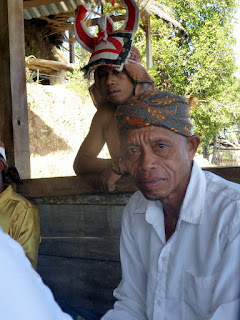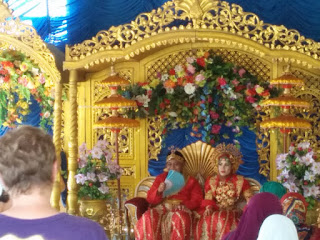Flores is populated by a total of 9 different tribes. Our local guide, Gusty (short for Augustin), is a member of the tribe we visited up a nasty hair-pin turned road in a village called Cecer (c is pronounced ch in Indonesia and k is always used for the hard 'c' sound).
We were greeted in a formal ceremony, treated to the local brew (fermented palm sap), and exchanged individual introductions from everyone. When everyone had been told ages, occupations, children, grandchildren and home state of everyone else, we left the meeting house for dances.
 |
When we first arrived, these women were providing music
(drums and gongs). It appears they start training early ;-). |
 |
Normally, there is an exchange of three different colored
chickens, but the more modern greeting is an exchange of
cash. Arinto appointed the one in our groups who had taken
the most OAT trips to be our spokesman. He and the village
headman exchanged cash and welcoming words three times. |
 |
These dancers were outside the raised meeting house where
we all went for the next stage of the greeting. |
 |
Inside the meeting house. This man, while not
the headman, answered many of the questions
that we asked. |
The first dance we saw looked like a warrior dance but was interpreted to be the father and mother protecting a person from misfortune. The second involved the story of the rice harvest. Next was a welcoming dance, a Filipino-style bamboo pole dance that involves skipping between moving poles without getting your ankles whacked. This was followed by a group rhythmic dance that we all participated in.
 |
The man on the left is the good guy and the one on the right
represents misfortunes attacking him. |
 |
| Another pair in the dance |
 |
The bow-like thing represents the strength of the
father and the shield is the protective mother. All
the other parts of the dance outfit were symbolic too. |
 |
There are 3 pairs of dancers who each took on the good and
bad guy roles. After each attack, the good guy reported to
the elders (men in white who formally observed) how he had
managed to fight off misfortune. |
 |
| Some of our group posed with the dancers. Jim is back left. |
 |
| The start of the rice dance |
 |
| Another rice dance stage |
 |
The welcoming dance. The women used the woven belts to
pull visitors into the dance. First were the men, then
another round with the women, |
 |
| Jim in the welcoming dance. |
 |
| Margo, Chris, and Marty tried this -- Marty was really good at it. |
This is a farming village that grows rice (it is wetter here than on the coast), candlewood, coffee, cloves, and vegetables. We walked to a home and practiced grinding coffee, and to another with women who were cracking hazel nuts and one was weaving on a simple loom.
 |
| Local women demonstrating how to grind coffee. |
 |
| Homer, Elaine, and I try it -- we never really got into a rhythm. |
 |
| Margo, Jim, and Mai grinding coffee. |
 |
A mom with two adorable kids. There were
a lot of cute kids here, though probably not as
many as in the past since the government is
encouraging families to stop at two kids. |
 |
| The simple loom used in this village |
 |
Women cracking nuts with the folded wood strips in their hands.
the nut goes in the folded end and is whacked against the
central rock. Several of us tried it -- harder than it looks! |
 |
I think it was laundry day. This family used their bushes as a
drying rack, which was not typical. |
 |
A typical house on the top half of the hill. The ones lower down
were not elevated but had concrete walls on the bottom 3 feet. |
Back on the bus we went back to town for lunch. As we got started, a very loud band started played just outside our window -- there was a wedding reception going an, which we went to look at after lunch. We were invited in to congratulate the couple and parents and were allowed to take pictures with them as well.
 |
Very elaborate setting for the bride and groom. Based on the
scarves the women wore, this was a Muslim wedding. Flores is
predominantly Catholic (Portuguese got here first), but 50% of
the Muslim population of the island lives here. |
 |
| Close up of the happy couple. |